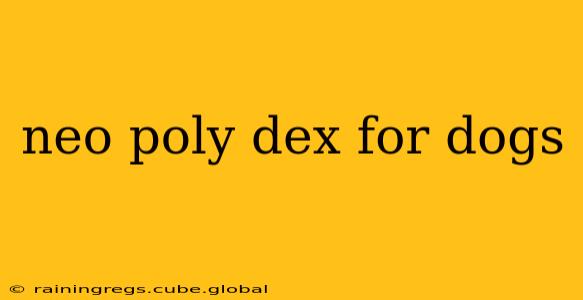Neo Poly Dex is a common veterinary ophthalmic solution used to treat various eye conditions in dogs. This comprehensive guide will delve into its uses, side effects, and precautions. Understanding this medication is crucial for responsible pet ownership and ensuring your canine companion receives the best possible care.
What is Neo Poly Dex?
Neo Poly Dex is a triple antibiotic ophthalmic ointment containing neomycin, polymyxin B, and dexamethasone. These ingredients work synergistically to combat bacterial infections and reduce inflammation in the eye. Neomycin and polymyxin B are antibiotics effective against a broad spectrum of bacteria, while dexamethasone is a corticosteroid that helps decrease swelling and irritation. This combination makes it a powerful tool in treating a range of canine eye problems.
What Conditions Does Neo Poly Dex Treat in Dogs?
Neo Poly Dex is prescribed by veterinarians to manage various canine eye infections and inflammations, including:
- Bacterial conjunctivitis: This common infection causes redness, swelling, and discharge in the eye.
- Blepharitis: Inflammation of the eyelids.
- Keratitis: Inflammation of the cornea (the clear front part of the eye).
- Post-surgical inflammation: Following eye surgery, Neo Poly Dex can help reduce inflammation and promote healing.
It's crucial to understand that Neo Poly Dex is a prescription medication. Never administer it to your dog without a veterinarian's explicit diagnosis and prescription. Improper use can lead to complications.
How is Neo Poly Dex Administered?
Your veterinarian will provide specific instructions on the dosage and frequency of application. Generally, a small amount of ointment is applied directly to the affected eye(s), usually several times a day. Always follow the veterinarian's instructions carefully.
What are the Side Effects of Neo Poly Dex in Dogs?
While generally safe and effective, Neo Poly Dex can have side effects in some dogs. These may include:
- Eye irritation: Some dogs may experience temporary burning or stinging upon application.
- Increased intraocular pressure (IOP): In rare cases, prolonged use of dexamethasone can lead to increased pressure within the eye, potentially damaging the optic nerve. Regular monitoring by a veterinarian is essential.
- Allergic reactions: Although uncommon, allergic reactions are possible. Symptoms can include redness, swelling, and itching around the eye.
If you observe any unusual reactions, discontinue use and contact your veterinarian immediately.
Can I use human ophthalmic ointment on my dog?
No. Human medications, even those seemingly similar, are not formulated for canine use and may contain ingredients toxic to dogs. Always consult your veterinarian for appropriate treatment.
How Long Does It Take for Neo Poly Dex to Work?
The time it takes for Neo Poly Dex to show improvement varies depending on the severity of the condition. You should start to see a reduction in symptoms within a few days, but complete healing may take several weeks. Consistent application as directed by your veterinarian is crucial for effective treatment.
What are the precautions I should take when using Neo Poly Dex for my dog?
- Wash your hands thoroughly before and after applying the ointment.
- Avoid touching the tip of the tube to the eye or any other surface to prevent contamination.
- Store the ointment as directed on the label to maintain its efficacy.
- Monitor your dog closely for any adverse reactions.
- Complete the full course of treatment, even if symptoms improve before the prescribed time. Stopping early can lead to recurrence of the infection.
- Inform your veterinarian about any other medications your dog is taking to avoid potential drug interactions.
This information is for educational purposes only and does not constitute veterinary advice. Always consult your veterinarian for diagnosis and treatment of your dog's eye conditions. They can accurately assess your dog's specific needs and recommend the best course of action.
